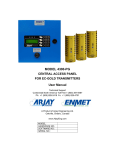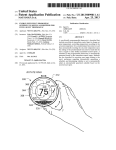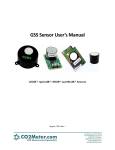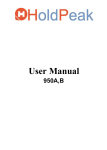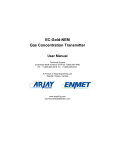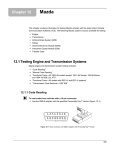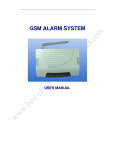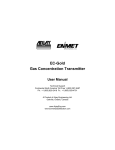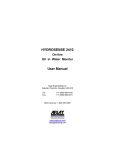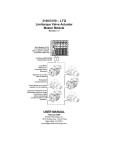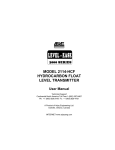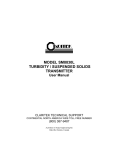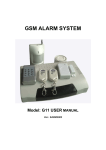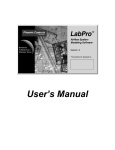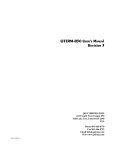Download MODEL 4300-PG
Transcript
MODEL 4300-PG CENTRAL ACCESS PANEL FOR EC-GOLD TRANSMITTERS User Manual Technical Support Continental North America Toll Free 1-(800) 387-9487 Ph: +1 (905) 829-2418 Fx: +1 (905) 829-4701 A Product of Arjay Engineering Ltd. Oakville, Ontario, Canada www.ArjayEng.com MODEL: HARDWARE NO.: SOFTWARE NO.: SERIAL NO.: Model: 4300-PG User Manual TABLE OF CONTENTS 1.0 2.0 3.0 INSTRUMENT OVERVIEW ............................................................................................4 1.1 Features .............................................................................................................5 1.2 Specifications .....................................................................................................6 INSTALLATION ..............................................................................................................7 2.1 Main Panel Installation .......................................................................................7 2.2 Sensor and RAB Installation ..............................................................................7 STARTUP AND CONFIGURATION ...............................................................................8 3.1 Status Indications ...............................................................................................8 3.2 Password Protection ..........................................................................................8 3.3 Display Screens .................................................................................................8 3.3 4.0 Zone Alarm Status Screen ..................................................................9 3.3.2 Real Time Screen ................................................................................10 3.3.3 Overall Alarm Status Screen ...............................................................10 3.3.4 Relay Analog Board (RAB) and MiniRAB Status Screen ....................10 3.3.5 Zone ppm Status Screen .....................................................................11 3.3.6 Individual EC-Gold Transmitter Status ................................................11 Notes on the user interface ................................................................................12 SETUP CONFIGURATION .............................................................................................13 4.1 Zone / Sensor Setup ..........................................................................................13 4.2 Remote Sensor Status .......................................................................................14 4.3 4300-PG Setup ..................................................................................................15 4.4 More Options (mA Output and Garage Code 120.6C) ......................................15 4.5 5.0 3.3.1 4.4.1 mA Output Setup .................................................................................16 4.4.2 Garage Code (120.6C) ........................................................................17 Fire input Code...................................................................................................18 CONTROL CONFIGURATION .......................................................................................19 5.1 Set Gas Alarm Values / mA Span ......................................................................19 5.2 Alarm Delay........................................................................................................20 5.3 Tools ..................................................................................................................20 5.3.1 Fan Cycle ............................................................................................21 5.3.2 Force 20mA Output .............................................................................21 5.3.3 Force Zone Alarms ..............................................................................21 2 Rev: 1.2 Model: 4300-PG User Manual 5.3.4 5.4 6.0 7.0 Fan Data Logging ................................................................................21 Relay Map Setup................................................................................................22 5.4.1 4300-PG Internal Relay Setup ............................................................22 5.4.2 Relay Analog Board (4300-RAB) Setup ..............................................23 5.4.3 Mini Relay Analog Board (miniRAB) Setup .........................................24 CALIBRATION SETUP ..................................................................................................25 6.1 Calibration ..........................................................................................................25 6.2 Calibration using EC-Gold Pushbutton ..............................................................25 6.3 Calibration from the 4300-PG ............................................................................25 6.3.1 Auto Calibration ...................................................................................26 6.3.2 Manual Calibration Methods................................................................26 6.4 Change Remote EC-Gold Transmitter Alarm Information .................................26 6.5 Change Remote EC-Gold Transmitter mA Output ............................................26 6.6 Record Calibration Date .....................................................................................27 SETTING SHEET............................................................................................................28 7.1 Gas Alarm Setup ................................................................................................28 7.2 Zone Parameter Setup .......................................................................................30 7.3 Relay Mapping ...................................................................................................32 7.3.1 4300-PG Internal Relay Mapping ........................................................32 7.3.2 Relay Analog Board (4300-RAB) Relay Mapping ...............................32 8.0 TROUBLE SHOOTING...................................................................................................38 9.0 DETAILED ELECTRICAL AND DIMENSIONAL DRAWINGS ......................................39 TABLE OF FIGURES Figure 1 – User Interface ...........................................................................................................8 3 Rev: 1.2 Model: 4300-PG 1.0 User Manual Rev: 1.2 INSTRUMENT OVERVIEW The Arjay Model 4300-PG is a flexible monitoring and control system for ventilation of Carbon Monoxide, Nitrogen Dioxide and/or Propane gas in apartment buildings, offices, commercial buildings, public parking facilities and maintenance garages. The 4300-PG unit is field configured for the number of zones (up to 16) and sensors per zone. The 4300-PG provides a central panel that continuously scans the field of sensors for gas concentrations. When a sensor indicates a High level of gas, the controller will determine its zone location and assign the appropriate fan to take action. Should the gas concentration continue to rise, additional fans can be called upon. The unique cross-mapping feature can call upon fans in different areas or garage levels or alert concierge, control room or security centers. In multi-level garages or garages with multiple fan locations, zone control and cross mapping optimizes energy efficiency by starting fans only in areas where ventilation is needed. When adequate ventilation is achieved, the fans automatically resume their normal speed or turn off. Using the above setup information, the 4300-PG unit continuously scans all the EC-Gold transmitters for their gas type and measured concentration. Up to 4 gas types are supported. For example, the 4300-PG may be configured to monitor Carbon Monoxide, Carbon Dioxide, Nitrogen Dioxide and/or Methane. The Low, High, High/High1 and High/High2 alarm values are independently entered for each gas. A Low alarm is triggered when the concentration of any target gas in that zone exceeds the Low alarm set value. There are total of 64 possible alarms: Low, High, High/High1 and High/High2 alarms per zone for up to 16 zones. Main Panel and Relay Analog Board (RAB) The 4300-PG supports four (4) internal relays plus maximum of 8 RABs with up to 8 relays each for a total of 64 relays. The 4300-PG communicates with the RAB via RS-485 Modbus. Therefore the RAB may be located conveniently anywhere on the sensor runs. Each of the 64 relays may be independently mapped in the field to any of the 64 alarms (Low, High, High/High1 and High/High2 for up to 16 zones). For Example, Relay1 may be mapped to Zone 1 Low Alarm as well as the High Alarm for all other zones. Relay2 may be mapped to Zone 2 Low Alarm as well as the High Alarm all other zones. This scheme will turn on the individual relays 1 and 2 when their respective zones go into Low alarm and both relays will turn on when any zone goes into High or High/High alarm. This flexibility ensures efficient use of the relays, which can be tailored to unique system requirements. The common Fault alarm is set if any EC-Gold transmitter has a fault or does not respond on the network. The Internal Relay1 can be designated as System Fault Alarm relay. Independent Delay to On and Delay to Off can be set for each gas alarm level (e.g. Low, High, High/High1 & High/High2). For each zone, the maximum ppm values are calculated and transmitted on 2 standard 4-20mA outputs. (If more than 2 mA outputs is required then a 4300-RAB must be purchased. Two mA outputs per RAB). 4 Model: 4300-PG 1.1 User Manual Rev: 1.2 Features Automatic scanning of up to 99 EC-Gold network sensors. Up to Six (6) wire runs from 4300-PG allowing more flexibility when wiring the EC-Gold sensors. Sensors may be assigned to any of 16 zones 2 Standard 4-20mA outputs assigned to any zone to reflect the zone’s max. ppm. (Optional Relays Analog Board (RAB) for zones greater than 2. Differential, independent Low, High, High/High1 & High/High2 alarms per zone. Alarm High and Low differential level may be independently set for up to 4 gases. Four (4) internal SPDT 3A relays plus up to 8 Relay Analog Boards (RAB) with up to 8 relays each and up to 8 mini Relay Analog Boards (miniRAB) with up to 3 relays each. Each relay is user selectable to be linked to any combination of alarm sources: Low, High, High/High1 & High/High2 alarms for all 16 zones. Internal Relay1 can be designated for System Fault Alarm. Optional output (200mA) linked to common High/High2 alarm for Buzzer and/or Red Pilot Light. Each Auxiliary relay board also has a Buzzer output and push to acknowledge input. Independent Delay to On and Off for all alarm level, plus a 60-minute override function in order to test system without time delay. Keypad accessible Test function for all zones alarms and 4-20mA or 0-20mA outputs. Real time clock for Calibration reminder setting. RS485 Modbus protocol to communicate with the EC-Gold sensors. RS485 and RS232 Modbus protocol for upstream BAS. Front panel LCD and membrane keypad user interface. Optional data logging for events using USB drive. Fan cycling on low alarm relays available in order to turn fans On in peak AM & PM periods. Fire alarm input to disable exhaust fans in case of fire. Occupied & unoccupied fault indication based on California garage ventilation (120.6C). Two range software available (e.g. Zone 1, sensor 1-10 & sensor 50-60). 5 Model: 4300-PG 1.2 User Manual Rev: 1.2 Specifications Power Input: 24VDC 250mA Max. (Controller only). 24VDC external power supply amperage depends on number of transmitters (100mA per sensor) User Interface: Calibration & Setup Network - 4 Line x 20 Character LCD and 4x4 membrane keypad. - RS-485 Modbus protocol connection to EC-Gold sensor. - RS-485 Modbus protocol connection to upstream BAS. - Differential Low, High, High/High1 and High/High2 alarms per zone for up to 16 zones. - Up to 4 gases are supported with independent Low, High, High/High1 and High/High2 alarms for each gas type. - Common Sensor Fault alarm - 4 internal SPDT 3A relays (Controller) and up to 64 external SPDT 10A/120VAC relays in banks of 8 (4300-RAB). - Each bank of 8 is accessible via RS-485 and may be located conveniently in garage area to save initial electrical wiring cost. - Each relay may be field linked to any combination of 64 alarm sources: Low, High, High/High1 and High/High2 alarms per zone for up to 16 zones. - Internal Relay1 may be designated as a System Fault alarm. Alarm Delay - Independent Delay to On and Delay to Off for each alarm level. Delay range: 0-99 minutes field adjustable Buzzer and/or Red Pilot Light (Optional) - Activated by any zone’s High/High2 alarm with acknowledge input. Each bank of 8 relays also includes a buzzer and acknowledge input. Max. 200mA. 4-20mA OR 0-20mA Outputs - 2 internal mA outputs and 2 per Relay Analog Board (4300RAB) Outputs: Alarms Relay Contacts Environmental: Ambient Temperature -20°C - 55°C Relative humidity 90% max. with no condensation Mechanical Specification: Refer to dimensional drawing 6 Model: 4300-PG 2.0 User Manual Rev: 1.2 INSTALLATION NOTE: If any damage to the instrument is found, please notify an Arjay Engineering representative as soon as possible prior to installation. 2.1 Main Panel Installation Choose a mounting location in accordance with good instrument practice. Extremes of ambient temperature and vibration should be avoided (see specifications and installation drawing). There are up to six (6) wire runs available for sensors. Sensors must be daisy chained along each wire (No T-Tapping). Zones are in a sequential format (e.g. Zone 1: 1-10, Zone 2: 11-20 etc.) All user connections are via mating plug/receptacle connectors to make installation and service easier. IMPORTANT NOTE: RS485 communication wire must be shielded and must not be run in same conduit as high voltage lines. The shield of the cable must be daisy chained as well as grounded to earth ground at main panel. If splitter boxes are used in ceilings, make sure the shields are also connected together. 2.2 Sensor and RAB Installation The sensors and RAB can be mounted up to 4000 feet maximum away from the main panel. (Longer wire runs may require a RS485 repeater). Recommended Cables: 1. For 24VDC Power: 2 Conductor 14-16AWG Shielded Cable 2. For RS485 Network: 2 Conductor Low Capacitance 22-24AWG Shielded Cable (Belden 9841, 3105A or equivalent) CAUTION: THE UNIT HOUSES SENSITIVE ELECTRONIC COMPONENTS AND SHOULD BE HANDLED WITH CARE. IF PUNCHING OR DRILLING THROUGH THE ENCLOSURE WALLS, MAKE SURE THAT THE INTERNAL ELECTRONIC MODULES ARE SHIELDED FROM DEBRIS ESPECIALLY METAL PARTICLES. PLEASE MAKE SURE THAT THE CONNECTIONS HAVE THE POLARITY AS INDICATED OR THE CONTROLLER MAY BE DAMAGED. USE GOOD INSTALLATION PRACTICE! DO NOT RUN HIGH VOLTAGE CABLE IN THE SAME CONDUIT AS SIGNAL WIRES. 7 Model: 4300-PG 3.0 User Manual Rev: 1.2 STARTUP AND CONFIGURATION Figure 1 – User Interface 3.1 Status Indications One LED per Relay status. Each relay is triggered by the user-selected combination of zone Low, High, High/High1 and High/High2 alarms. 3.2 Password Protection A password must be entered to access any of the 3 value entry menus: CALIB, CONTROL, SETUP. The factory default password is 2000. The prompt for entering the password is always 9999 regardless of the actual password. 3.3 Display Screens After power up and the initial startup screen has been displayed for about 3 seconds, the CAP scans all active EC-Gold transmitters on the network (as set by the "number of remotes" setting explained later). This may take several seconds depending on the number of sensors. The following screen will now appear: Z Z Z Z 1: 2: 3: 4: Ok Ok Ok Ok PLEASE NOTE: ALL DISPLAYS SHOWN IN THIS MANUAL ARE FOR EXAMPLE ONLY. ACTUAL VALUES WILL BE VARY. 8 Model: 4300-PG User Manual Rev: 1.2 3.3.1 Zone Alarm Status Screen The following is a typical display: Z Z Z Z 1: 2: 3: 4: Ok Ok Ok Ok The alarm status is displayed for each zone. If there are more than 4 zones, press the <DISPLAY> key to view the status of the remaining zones. Each line starts with the zone number and displays the zone status. The status may be one of the following: OK All EC-Gold transmitters in this zone are responding on the network, are functioning properly and there are no gas alarms. Low Alarm At least one EC-Gold transmitter in this zone has a ppm level at or above the Low Alarm ppm level for at least the Low Alarm Delay On time. High Alarm At least one EC-Gold transmitter in this zone has a ppm level at or above the High Alarm ppm level for at least the High Alarm Delay On time. HiHi1 Alarm At least one EC-Gold transmitter in this zone has a ppm level at or above the High/High1 Alarm ppm level for at least the High/High1 Alarm Delay On time. HiHi2 Alarm At least one EC-Gold transmitter in this zone has a ppm level at or above the High/High2 Alarm ppm level for at least the High/High2 Alarm Delay On time. No response (NR) At least one EC-Gold transmitter in this zone is not responding on the network. DEL> Alarm Delay ON DEL< Alarm Delay OFF Fan Cycle ON CAL or CAL REMINDER Sensor Calibration Reminder Sensor Fault (ERR) Indicates that one of the sensors in the zone is in fault. Check zone status (Sec. 3.3.6) to see which sensor is in error (ERR) and then sensor status in setup menu to see which fault code. 9 Model: 4300-PG User Manual Rev: 1.2 3.3.2 Real Time Screen To view this screen, press the <ENTER> key while viewing the Zone alarm status screen. Current Date / Time 2013/06/30 19:19:19 YYYY/MM/DD HH:MM:SS Press <ENTER> key to return to Zone alarm status screen. 3.3.3 Overall Alarm Status Screen To view this screen, press the <DISPLAY> key while viewing the Zone Alarm Status Screen. Max ppm=25 by #5 Network: OK Sensors: OK Alarm status: Low The top line displays the maximum ppm registered by any EC-Gold transmitter in any zone and the transmitter network address which caused it. The second line displays the network status: either “OK” if all active EC-Gold transmitters and networked resources are responding, or “Net no response: x” and the number (quantity) of not responding transmitters or networked resources is displayed. For example if 1 EC-Gold transmitter and 1 RAB board are not responding then "Net no response: 2" is displayed. The third line displays the common EC-Gold transmitter status. This includes EC-Gold transmitters that have sensor faults or if they are not responding on the network. If all EC-Gold transmitters are OK, then “OK is displayed, else “Sensor Fault: x” is displayed where “x” is the number (quantity) of EC-Gold transmitters with sensor or instrument faults or not responding. Note: if an EC-Gold transmitter is not responding then this will be indicated on line 2 and 3 i.e. you will get “Net no response” and “Sensor Fault” errors. Press zone alarm status screen (Section 3.3.1) to see which zone is in fault. Then press the appropriate zone # to see which actual sensor is in fault. Sensor status in setup menu can determine which fault code (see Section 4.2 for more info). 3.3.4 Relay Analog Board (RAB) and MiniRAB Status Screen To view this screen, continually press the <DISPLAY> key until the Overall Alarm Status Screen appears. RAB1: OK RAB2: OK miniRAB1: OK miniRAB2: OK This screen will only show up if 4300-RAB were purchased. This screen will only show up if miniRAB were purchased. The status of the RAB is displayed. If only one RAB module is installed, the bottom 3 lines are blank. “OK” means the RAB module is responding on the network. 10 Model: 4300-PG User Manual Rev: 1.2 3.3.5 Zone ppm Status Screen To view this screen, continue to press the <DISPLAY> key until the Zone ppm Status Screen appears. Z1Hi/Av: Z2Hi/Av: Z3Hi/Av: Z4Hi/Av: 25(05)/ 3 12(11)/ 5 0(20)/ 0 0(32)/ 0 The ppm status is displayed for each zone. If there are more than 4 zones, press the <DISPLAY> key to view the status of the remaining zones. Each line starts with the zone number. The first value is the highest ppm recorded for that zone together with the transmitter network address causing this value. The average value for the entire zone is displayed at the end of the line. In the example above, zone 1 has a high of 25ppm caused by EC-Gold transmitter # 5. The average for the zone is 3 ppm. 3.3.6 Individual EC-Gold Transmitter Status The status of individual EC-Gold transmitters within each zone may be viewed by pressing the following keys on the keypad while in any of the screens described above in sections 3.3.1 – 3.3.5: Press the zone number to get to the corresponding zone sensor status. For example for zone 1 press “1”. The ENTER key does not need to be pressed. If there is two ranges of sensors within one zone then Press that particular zone # a second time to see the second range of sensors. Note: Press ENTER to go to next zone instead of going back to main screen. z1 ppm: 01:000 02:000 03:NR In order to view zones greater than 9, Press DISPLAY key until the range with that particular zone shows up. For example to view zone 14 Press DISPLAY key until range 13-16 shows up. Press the numeric code that corresponds to the zone as per table. Example: If you would like to see zone 14, Press “4”. 0 For Zone 10 3 For Zone 13 1 For Zone 11 4 For Zone 14 2 For Zone 12 5 For Zone 15 6 For Zone 16 The status of individual EC-Gold transmitters for the corresponding zone are displayed 11 at a time. If more than 11 transmitters are assigned to the zone, then press the ENTER key repeatedly to view the status of remaining EC-Gold transmitters, 11 at a time. For each EC-Gold transmitter, the ppm value is displayed beside each sensor number. Or the status is displayed by an alpha code: 11 Model: 4300-PG User Manual Rev: 1.2 NR = no response from EC-Gold ERR = Sensor Fault Pressing the <DISPLAY> key when the last transmitter is on screen cycles back to Zone Alarm Status screen. 3.3 Notes on the user interface When entering in numeric values, the cursor can be backspaced to correct mistakes by pressing the DISPLAY key. This is only true if the cursor is not at the beginning of the displayed value, in which case the DISPLAY menu is entered. Values may be entered with any number of decimal places. If the entered value is out of the allowed limits, the system displays the limiting value for 2 seconds. For example if a gas concentration, Calibration value is entered as 5000.0 then MAX. 999 is displayed for 2 seconds then entry is allowed again. The current value is not changed unless the entered value is within limits. 12 Model: 4300-PG 4.0 User Manual Rev: 1.2 SETUP CONFIGURATION Press <SETUP> key, enter the password at the prompt and access to SETUP main screen. The default factory set password is 2000. Press <SETUP> key any time to return to SETUP main screen. ****** SETUP ******* 1-Zone/Sensor Setup 2-Sensor Status 3-CAP Set 4-more 4.1 Zone / Sensor Setup The following is factory defaulted for “One Range” software. Therefore, there is only one range of sensors per zone (e.g. Zone 1: Node# 1-10). If an additional phase of parking is added to a zone at a later date or user may requires the same zone # on two different wire runs then “Two Range” software is required (consult factory for this feature). Following steps are for both “One Range” and “Two Range” software: From SETUP main screen, Press <1> key for Zone / Sensor setup. 1. Enter the total number of EC-Gold transmitters (note: Include both phase of sensors if two range software is ordered) on the network followed by the ENTER key. Note: this value includes transmitters in all zones. The 4300-PG unit assumes sequential addresses starting from 1 to the last number of sensor entered. i.e. if 14 is entered then addresses 1 to 14 are considered active. Up to 99 transmitters are available. 2. Next, at the prompt, enter the number of zones require (maximum is 16). There are 6 wire runs available from the 4300-PG to allow greater flexibility in wiring the ECGold transmitters. User must specify which zone(s) and range of EC-Gold node addresses are wired in each wire run. Following step is for “One Range” software: 3. At the prompt for each zone, enter Wire run number first, then enter the first and last transmitter network addresses for each zone. See note 1 below. Following step is for “Two Range” software: 4. At the prompt of 1st range, enter zone number, wire run number and enter the first & last transmitter network addresses respectively of the 1st range. Now at the prompt of 2nd range, enter wire run number, then enter the first and last transmitter network addresses of the 2nd range. For example: Zone 1: Sensor 1 – 5 may use wire run#1 while a second range of sensors may be added at a later date. Therefore, second range of sensors for zone 1 may be Zone 1, Wire Run 1: Sensor 50-60 sensors. NOTE 1: A maximum of 99 transmitters may be selected for a zone as long as they have sequential network addresses (Factory recommendation is to wire only maximum 50 sensors per wire run). Also, the end address must always be greater than the start address. For example, zone 1 addresses 1-5; zone 2 addresses 6-14 and so on. 13 Model: 4300-PG User Manual Rev: 1.2 Setup Zone 1 Wire Run # 1 First Sensor # 1 Last Sensor # 5 In this example, sensors with node address 1-5 must be physically mounted within this zone. 4.2 Remote Sensor Status From SETUP main screen, Press <2> key for Remote EC-Gold sensor status. Sensor ID: Zone01-01 1-Change Sensor ID 2-Sensor Values/Stat 3-Revisions / ID The first line shows current sensor ID (for example: sensor #1). 1. Press <1> to change current EC-Gold transmitter ID. Enter desired # and press ENTER. REMOTE SENSOR SELECT Address #: 1 2. Press <2> to view the current EC-Gold transmitter Gas name, Zone #, ppm value, mV value and Calibration Status. Zone01: 01 STATUS CO : 0ppm 18mV Cal Stat: ok Press <Enter> button to view the next sequential sensor. 3. Press <3> to view current EC-Gold transmitter Software Revision, Hardware Revision and Serial Number. Z01: 01 REVISIONS/ID SW rev: X.X HW Rev: X.X S/N: XXXXXX 14 Model: 4300-PG 4.3 User Manual Rev: 1.2 4300-PG Setup From SETUP main screen, Press <3> key for CAP setup CAP CONFIGURATION 1-CAP ID 2-CAP Info 3-Date/Time Setup The 4300-PG may be accessed via an RS-485 link using the Modbus protocol. The BMCS acts as a modbus master. The 4300-PG must be given a unique address so it can specifically be accessed by the BMCS. 1. Press <1> for CAP ID number. Enter the desired number. This value is typically already set at 1. CAP NET ADDRESS Enter new address: 1 Press <2> to review CAP information such as Software Revision, Hardware Revision and Serial Number. *CAP INFORMATION* SW Rev: X.X HW Rev: X.X S/N: XXXXXX 2. Press <3> to setup current Year, Month and Day (yyyy/mm/dd) and Time (hh:mm:ss). Date & Time Setup 2015/01/12 12:18:42 1-Change Date 2-Change Time 4.4 More Options (mA Output and Garage Code 120.6C) From Setup Main screen press <4> (more). This will allow for setup of mA outputs and setup of garage code 120.6C (consult factory for this feature). Current= 4-20mA Output 0 = change to 0-20mA 1 = mA out setup 2 = Garage code 120.6C * *shown if required for local jurisdiction. Top line shows if mA output is 4-20 or 0-20 output. Press <0> key to change desired output. 15 Model: 4300-PG User Manual Rev: 1.2 4.4.1 mA Output Setup From 4-More screen, press <1> key for mA Out setup. mA1=DIS 1=Enable mA2=DIS 3=Enable RAB mA=DIS 5=Enable Enter=continue There are two 4-20 mA output channels on 4300-PG and two 4-20mA outputs per 4300-RAB that can be enabled or disabled. Unless mentioned at time of order, this is factory disabled for faster software efficiency. These two mA output channels on the 4300-PG control module can be set to link any two zones. There are two 4-20 mA output channels on each RAB board (AOUT1 & AOUT2). These two mA output channels can be set to link any two zones. mA1 = DIS: mA channel 1 is currently disabled. Press <1> to enable mA channel 1 output. mA 2 = DIS: mA channel 2 is currently disabled. Press <3> to enable mA channel 2 output. RAB mA = DIS: RAB mA outputs are currently disabled. Press <5> to enable RAB mA outputs. When mA output are enabled, press <ENTER> to setup 4300-PG mA outputs to a desired zone mA output, or display RAB mA outputs. mA1 Out - Enabled mA2 Out - Enabled RAB mA - Enabled 1-mA1 2-mA2 3-RAB mA Press <1> to set up 4300-PG mA Out #1: mA Output Setup Total 5 zones mA Output #1: z 1 Enter new Zone #: 4300-PG mA Output #1 is currently linked to zone1 mA output. Enter new zone number will set mA output #1 link to the new zone mA output. The main screen will automatically switch to mA Output #2. Enter the desired zone for mA #2. 16 Model: 4300-PG User Manual Rev: 1.2 Press <3> to change RAB mA output: #1 mA SETUP TOTAL 5 ZONES mA OUT #1: Z2 Enter new zone#: Line 3 will show the existing zone that mA#1 is linked to. Enter new zone number if required and Press <ENTER>. mA #2 for RAB#1 will then show. Enter new zone number if required and Press <ENTER>. Press <ENTER> to get back to SETUP main screen. If more than one RAB is used then the menu will automatically display the 2nd RAB (e.g. Node 101). 4.4.2 Garage Code (120.6C) From 4-More screen, press <2> key for Garage Code 120.6C setup. Garage Code 120.6C 1=occupied period 2=occupied test The following is based on California Garage Ventilation Code (126.6C). This code is based on sensor fault conditions during occupied & unoccupied periods that the garage is in operation. Occupied period is the time that the parking garage is open for operation. Press <1> to enter the time that the garage is in operation. Set Occupied Period Start time 8 Off time 14 Note: 14 is based on international standards or military time (e.g. 14 = 2 o’clock). If there is a sensor fault due to one of the three criteria of garage code (120.6C) then display will show sensor fault. Press the appropriate zone # to determine which sensor has gone into fault. This would be shown as ERR. Go to sensor status on Setup menu to determine which garage code is in fault. Press <1-3> to conduct a test for sensor failure within a 5 minute test period based on NA7.12 Parking Garage Ventilation System Acceptance Tests. 1 2 3 E = = = = 5 mins CAL test 5 mins Unoccu test 5 mins Occu test Back to setup menu 17 Model: 4300-PG User Manual Rev: 1.2 1) Calibration Period (5 mins CAL test) (Status Code “CAL”) If any sensor has not been calibrated according to the manufacturer’s recommendations within the specified calibration period, the sensor has failed (Fault Code:_CAL_). This will turn on fault and low alarm. Go to calibration menu to reset CAL reminder. Press <1> to test calibration period test. This will count down from 5 minutes until the test is complete in which case. The fault relay and low alarm relay should go into alarm. Display should show “Calibration Period Test Done”. Press <0> to exit test mode. 2) Unoccupied Period (5 mins Unoccu Test) (Status Code “2”) During unoccupied periods the system compares the readings of all sensors, e.g. if any sensor is more than 15 ppm above or below the average of all sensors for longer than 4 hours, the sensor has failed. (Fault Code:_ 2 _). This will turn on fault and low alarm. Go to sensor status screen to determine which sensor has high ppm value. Press <2> for unoccupied test. During this test if any sensor is more than 1ppm above or below the average of all sensors during 5 minutes, then system will show fault and enable low Alarm exhaust fans. Once test is done then press <0> to exist. 3) Occupied Period (5 mins Occu Test) (Status Code “3”) During occupied periods the system compares the readings of sensors in the same proximity zone, e.g. if the 30 minute rolling average for any sensor in a proximity zone is more than 15 ppm above or below the 30 minute rolling average for other sensor(s) in that proximity zone, the sensor has failed. (Fault Code:_ 3 _). This will turn on fault and low alarm. Go to sensor status screen to determine which sensor has high ppm value. Press <3> for occupied test. During this test if any sensor is more than 1ppm above or below the average of all sensors during 5 minutes, then system will show fault and enable low Alarm exhaust fans. Once test is done then press <0> to exist. 4.5 Fire input Code The following feature is used to hook up to the fire alarm panel. - In case of fire all relays for fan will control be locked out. The following message would be displayed - Connect dry contact from fire alarm panel to terminal 3 & 4 of TB6. FIRE ALARM No Action on all Relays 18 Model: 4300-PG 5.0 User Manual Rev: 1.2 CONTROL CONFIGURATION Press <CONTROL> key, enter the password at the prompt and access to CONTROL main screen. The default factory set password is 2000. CAP CONTROL SETUP 1-Gas alarms/mA Span 2-Alarm Delay 3-Tools 4-Relay Set 5.1 Set Gas Alarm Values / mA Span From CONTROL main screen, Press <1> for Gas Alarms / mA Span. 1. Select a number (1-4) to select a gas with which to associate alarm differentials. For example in a system with CO and NO2 EC-Gold transmitters, Gas#1 is set for CO and Gas#2 for NO2. Gases #3 and 4 are set to Not Used (code 23). 2. After pressing a Gas number, select the gas type by pressing a 2 digit gas code from 0 to 23 followed by the ENTER key. For each code entered, the corresponding gas is selected, with a prompt to press 1 to accept the selection or 2 to select another gas. The supported gases and their corresponding codes are shown below in the table: GAS NAME CODE Carbon Monoxide: CO (ppm) Nitrogen Dioxide: NO2 (ppm) Methane: CH4 (%LEL) Propane: C2H5 (%LEL) Hydrogen Sulfide: H2S (ppm) Ammonia: NH3 (ppm) Chlorine: Cl (ppm) Oxygen: O2 (%) Gasoline (%) Hydrogen: H2 (ppm) Toxic (ppm) – generic name Combustible (%LEL) – generic name BRH (Broad Range Hydro Carbon) (ppm) Carbon Dioxide: CO2 (ppm) Acetylene (ppm) Sulfur Dioxide: SO2 (ppm) ClO2 (ppm) Hydrogen Chloride: HCl (ppm) Hydrogen Cyanide: HCN (ppm) Ozone: O3 (ppm) Nitric Oxide: NO (ppm) Temperature in deg. C Temperature in deg. F NOT USED 00 01 02 03 04 05 06 07 08 09 10 11 12 13 14 15 16 17 18 19 20 21 22 23 19 Model: 4300-PG User Manual Rev: 1.2 3. After selecting the desired gas by pressing 1 in step above, enter the high and low differential ppm level for the Low Alarm. The gas concentration must rise above the high differential to set the Low Alarm and must fall below the low differential to clear the Low Alarm. 4. After setting the Low Alarm differential level, the system automatically prompts for the High, High/High1 and High/High2 alarms differential levels. 5. Enter the value for ppm of CO for 4mA and 20mA. This is typically 0ppm = 4mA and 200ppm = 20mA. User may set the 4mA for another value such as 25ppm when using mA output for VFD exhaust fans. Therefore, the fans will not start until 25ppm level is reached. 5.2 Alarm Delay From CONTROL main screen, Press <2> for Alarm Delay ALARM DELAY SETUP 1-Set Alarm Delay 2-Override Delay s Current = Delay mode. 1. Press <1> to Set Alarm Delay. Set Low Alarm Delay On and Delay Off value in minutes, the system automatically prompts for the High, High/High1 and High/High2 alarm delay on and delay off time in minutes. ON delay is the amount of time required to activate an alarm after a sensor has reached that preset ppm value. OFF delay is the amount of time required to de-activate an alarm after a sensor has dropped below that preset ppm value. The system will automatically return to the control main screen after all values have been entered. 2. Press <2> for Override Delays. Press <1> to temporarily override the Delays On and Off values. This allows the user to test the system without having to wait for any preset time delay. 3. Press <2> to restore relay delays on and off value. The relay on and off values will be restore automatically after 60 minutes. Press Control button to exit this screen. 5.3 Tools From the Control main screen, press <3> for tools. 1-Fan Cy cle Setup 2-Force 20mA 3-Force Zone Alarms 4-Fan Data logging 20 Model: 4300-PG User Manual Rev: 1.2 5.3.1 Fan Cycle This feature operates the fans during peak time periods. Press <1> for Fan Cycle setup. There are two Fan Cycle features (morning and afternoon). Both fan cycles features can be enabled or disabled. The first and third line shows the present status. AM Fan Cycle OFF 1- AM Cycle ON 2- PM Fan Cy cle OFF 3- PM Cy cle ON Press <1> to Enable OR Disable AM Fan cycle and Press <3> to Enable OR Disable PM Fan cycle. If the function is enabled then the following will be displayed: 2-Cyc Set for AM 4-Cyc Set for PM. Press either function in order to set the desired ON and OFF time between 1 to 12 o’clock. Note when entering AM times it is set in international or military time (e.g. 14 = 2 o’clock). 5.3.2 Force 20mA Output Press <2> to force the 4-20 mA. This function is used to force a 20mA output in order to verify external devices. Press <2> again to release this feature and get back to main display. 5.3.3 Force Zone Alarms Press <3> to force zone alarms. This function is to test each zone alarm condition in order to verify proper relay mapping and fan operation. Press the desired zone that you want to test. Each alarm level will show for that particular zone. Press appropriate alarm level for selected zone. After testing has been preformed, Press <0> to release this function. 5.3.4 Fan Data Logging This feature is used to record total fan run time from start date. This data can be used for energy saving rebates. These values will update at 1AM & 1PM. Press <4> to Fan Run Time function and then Press 1 to 4 to record for desired internal relays. Fan Run Time Setup Internal Relay s: 1-R1 2-R2 3-R3 4-R4 5- Remote RAB relays Int. R1 Start Record On: 2013/08 (m) /01 (d) XXXX Day s XX Hours XX Mins 1 – Reset Fan Run Time Record the date from line 2 and the total fan run time from line 3. Press <1> to reset if required. Press <5> to record RAB relays. Enter the desired RAB node address and then the desired relay within that RAB. 21 Model: 4300-PG User Manual RAB Fan Run Time Remote RAB Node: 100 RAB Relay No.: 1 Rev: 1.2 RAB1 R1 Start Record On: 2013/08 (m) /01 (d) XXXX Day s XX Hours XX Mins 1 – Reset Fan Run Time Record the date from line 2 and the total fan run time from line 3. Press <1> to reset if required. 5.4 Relay Map Setup From the Control main screen, press <4> for relay map setup. 4300-PG has 4 internal relays, and each RAB ordered has 8 relays and miniRAB has 3 relays. RELAY MAP SETUP 1-Internal Relay s 2-Ext. RAB Relays 3- miniRAB 5.4.1 4300-PG Internal Relay Setup (Note: Relay mapping should be done after all zone / sensors setup (Section 4.1) has been performed. Refer to Section 7.3.1 if mapping has been performed at time of shipment. 1. Press <1> for 4300-PG internal relay setup. The internal relay 1 (R1) can be set as a System Fault alarm or as a set point alarm relay. R1: Fault 0-Fault 9-Non Fault Mapping Relay s: 2-R2 3-R3 4-R4 2. The first line displays the current relay 1 (R1) setting.Press <0> to set R1 as Fault relay OR press <9> to set R1 as a setpoint relay. 3. Press <2> to map relay 2 (R2). Press <ENTER> key after reading the description screen. A screen similar to the following is displayed. The map shown is an example only. The actual values will vary. This screen shows the map for Integral Relays 2 (R2). If the Integral Relay1 has been set for System Fault, then it is excluded from other alarms. The column headings are for the Low (L), High (H), High/High1 (1) and High/High2 (2) alarms for each zone (z1 to z4). Enter the mapping as follows: Internal Relay : R2 Z1 Z2 Z3 Z4 LH12 LH12 LH12 LH12 YNNN YNNN YNNN YNNN 22 Model: 4300-PG User Manual Rev: 1.2 4. The cursor starts at the Low alarm column for zone 1. Press 1 to establish a link: press 0, to clear the link. If there are more than 4 zones then complete the entries for the first 4 zones for each relay and the remaining zones are automatically displayed. Unused zones are not displayed. To advance the cursor to the next column with no change: press the ENTER key. To advance to the next screen: press any other numeric key. Note: changes are made as soon as the ‘1’ or ‘0’ key is pressed. If a mistake is made, you will need to exit the menu, and then re-enter to change the value. 5. After completing the maps for relays 1 and 2, the system automatically prompts with the maps for all remaining relays. 5.4.2 Relay Analog Board (4300-RAB) Setup From the Control main screen, press <4> for relay setup. Each RAB has 8 relays. 1. Press <2> for External RAB relay setup. SET # OF RAB MODULES Enter how many RAB 3 2. Enter how many RAB(s) used and Press <ENTER> key. After reading the description screen. PRESS Enter to continue. A screen similar to the following is displayed. Only selected RAB(s) will be displayed. 1-RAB #1 2-RAB #2 3-RAB #3 4-RAB #4 5-RAB #5 6-RAB #6 3. Press<1> for RAB #1 relay mapping. Enter the wire run # for the 4300-RAB was wired at the main controller. Press <ENTER> to continue, and the similar screen will be displayed. If there is no communication to this particular RAB then “ERR: Can’t access RAB” will display. Troubleshooting will be required. RAB #1, Relay : #1 Wire Run #: 6 RAB #1, Relay : #1 Z1 Z2 Z3 Z4 LH12 LH12 LH12 LH12 YNNN YNNN YNNN YNNN 4. The cursor starts at the Low alarm column for zone 1. Press 0 to establish a link, Press 0 to clear the link. If there are more than 4 zones then complete the entries for the first 4 zones for each relay and the remaining zones are automatically displayed. Unused zones are not displayed. To advance the cursor to the next column with no change: press the ENTER key. To advance to the next screen: press any other numeric key. Note: changes are made as soon as the ‘1’ or ‘0’ key is pressed. If a mistake is made, you will need to exit the menu, and then re-enter to change the value. 5. After completing the maps for relays 1, the system automatically prompts with the maps for relay 2 of this RAB. 23 Model: 4300-PG User Manual Rev: 1.2 5.4.3 Mini Relay Analog Board (miniRAB) Setup From the Control main screen, press <4> for relay setup. Each miniRAB has 3 relays. 1. Press <3> for miniRAB relay setup. SET miniRAB Relay Enter No. of miniRAB 3 2. Enter how many miniRAB’s used and Press <ENTER> key. After reading the description screen. PRESS Enter to continue. A screen similar to the following is displayed. Only selected miniRAB(s) will be displayed. 1-miniR.1 3-miniR.3 2-miniR.2 3. Press<1> for miniRAB.1 relay mapping. Enter the wire run # for the miniRAB was wired at the main controller. Press <ENTER> to continue. Enter the network node address of this miniRAB being used and then press <ENTER>. If there is no communication to this particular miniRAB then “ERR: Can’t access RAB” will display. Troubleshooting will be required. miniRAB: #1, Relay: #1 Wire Run #: 6 miniRAB: #1, Relay: #1 Network ID: 20 miniRAB #1, Relay: #1 Z1 Z2 Z3 Z4 LH12 LH12 LH12 LH12 YNNN YNNN YNNN YNNN 4. The cursor starts at the Low alarm column for zone 1. Press 1 to establish a link, Press 0 to clear the link. If there are more than 4 zones then complete the entries for the first 4 zones for each relay and the remaining zones are automatically displayed. Unused zones are not displayed. To advance the cursor to the next column with no change: press the ENTER key. To advance to the next screen: press any other numeric key. Note: changes are made as soon as the ‘1’ or ‘0’ key is pressed. If a mistake is made, you will need to exit the menu, then re-enter to change the value. After completing the maps for relays 1, the system automatically prompts with the maps for relay 2 of this miniRAB. THIS CONCLUDES THE 4300-PG SETUP. FOR THE CALIBRATION OF INDIVIDUAL EC-GOLD TRANSMITTERS REFER TO THE NEXT SECTION. 24 Model: 4300-PG 6.0 User Manual Rev: 1.2 CALIBRATION SETUP The 4300-PG acts as a user interface to the remote EC-Gold transmitter being calibrated. The resulting setup and calibration values reside in the EC-Gold transmitter and not in the 4300-PG. 6.1 Calibration The EC-Gold transmitter is pre-calibrated at the factory, but field verification with a known concentration of test gas should be performed to ensure proper operation of the system. Manufacturer recommendation is Field Calibrations should be scheduled every 6 months as part of a regular maintenance program. Local jurisdiction may require different calibration frequency. The EC-Gold transmitters may be calibrated using the 4300-PG or at the EC-Gold itself using the convenient single point pushbutton procedure. Calibration involves exposing the sensor of the EC-Gold transmitter with a calibration gas. As such, calibration at the EC-Gold is quickest. Calibration via the 4300-PG is practical if there are 2 people equipped with 2 way radios calibrating the EC-Gold transmitters (one at the 4300-PG and the other gassing the sensors). A handheld calibrator may also be purchased for easy calibration. 6.2 Calibration using EC-Gold Pushbutton To calibrate the EC-Gold transmitters using the integral calibration pushbutton, refer to the ECGold manual for the latest calibration procedure information. 6.3 Calibration from the 4300-PG The following procedure describes how to individually calibrate any remote EC-Gold transmitter from the 4300-PG unit. As mentioned earlier, this method is most convenient if performed by 2 people communicating via radio transceivers. This method is also preferred if the calibration gas can be selectively applied to the EC-Gold transmitters via tubing from a centrally located calibration gas canister. In this scenario, one person can conveniently perform calibration. The following procedure describes calibrating from the 4300-PG panel. 1. Press the <CALIB> key, then enter the password at the prompt to access Calibration main screen. The factory set password is 2000. SENSOR CALIBRATION 1-Calibration 2-Alarms 3-mA Set 4-Record Calibration 2. Press 1 for Calibration from the Calibration menu. 3. Select the desired Network ID of EC-Gold transmitter to be calibrated and then Press <Enter>. 4. The calibration menu offers 3 types of calibration: Auto cal, Manual cal and direct entry of the slope and offset. 25 Model: 4300-PG User Manual Rev: 1.2 6.3.1 Auto Calibration Autocal is the most common form of calibration. In this procedure, the gas sensor is exposed to 2 different gas concentrations in turn – one of which can be clean air (0 ppm CO). The concentration value is entered for each. The EC-Gold is automatically instructed to calculate the required calibration parameters: 1. From the Calibration menu press 1 for Autocal. 2. Gas the EC-Gold sensor being calibrated with the first gas. Ambient air can be used as 0 ppm ONLY if it is certain that there is no CO in the air. Enter the concentration of the first gas in ppm for this first point then Press <Enter>. The bottom line displays the raw sensor reading in mV and is displayed to give an indication when the reading has settled. This typically takes about 1 minute. Press Enter to confirm the first calibration point. 3. This display now prompts for the second calibration point. Remove the first calibration gas and let the sensor settle in air until the reading returns to clean air levels. 4. Repeat step 2 with the second gas concentration. (This is typically 100ppm CO Carbon Monoxide or 10ppm NO2) 5. In the event of calibration errors such as low sensor sensitivity, or “No change in sensor”, an error message is flashed for about 2 seconds after the <ENTER> key has been pressed. Calibration will have to be performed again after troubleshooting the problem (e.g. bad sensor). 6.3.2 Manual Calibration Methods There are 2 other methods. Both require a prior successful autocal. The first method allows manual entry of 4 values: the concentration and raw sensor values for each of 2 cal points. The EC-Gold is then instructed to calculate the required calibration parameters. The final cal method is to directly enter the calibration values i.e. the SLOPE sensitivity) and the OFFSET (or raw value in 0 ppm CO). 6.4 Change Remote EC-Gold Transmitter Alarm Information This feature allows the user to change the alarm values at each sensor. This will not override the 4300-PG alarm values. This is strictly for LED indication at EC-Gold sensor only. 1. Press <2> for Alarms in Calibration main screen. 2. Enter desired Network ID number. 3. Change remote EC-Gold transmitter alarm values if needed. 6.5 Change Remote EC-Gold Transmitter mA Output The mA output from each EC-Gold is typically not used in 4300-PG panels. Therefore, this feature may not need to be accessed. 1. Press <3> for mA Out in Calibration main screen. 2. Enter desired Network ID number. 3. Change remote EC-Gold transmitter mA output span, or trim mA output. 26 Model: 4300-PG 6.6 User Manual Rev: 1.2 Record Calibration Date This feature is used to display a calibration warning after a preset time period. The warning “CAL REMINDER” or “CAL” will show up on the right hand side of main display after the preset calibration time has past. A buzzer (if ordered) will beep every minute to warn that calibration is needed. 1. Press <4> to record calibration date under Calibration main screen Record Calibration 1-Record Cal Date Cal Date: 2013/06/30 2-Cal Period Setup 2. Press <1> to record current date as the calibration date. 3. Press <2> to setup calibration period days. The default is 180 days. The calibration reminder will display if the operating days (current date minus last recorded calibration date) are more than the calibration period days. Current CAL period 180 days 1 – Enter New Period 2 – Exit 27 Model: 4300-PG 7.0 User Manual Rev: 1.2 SETTING SHEET Checked by Model Number Serial Number Hardware Revision Software Revision The factory settings column below lists the typical default settings. The user may change these values. If changed, please fill in the USER SETTING column for future reference. 7.1 Gas Alarm Setup Gas alarms may be set for up to 4 gases. Alarms are checked based on the gas type setting in EC-Gold Transmitters. For example, in a system with EC-Gold transmitters for CO and NO2, enter separate alarm values for CO (Gas #1) and for NO2 (Gas #2). Gases #3 and #4 are set to UNUSED. High Alarm high differential Concentration of any EC-Gold transmitter in the zone must exceed this value for at least the the Low Alarm delay to ON period to activate the Low Alarm. Concentration of all EC-Gold transmitters in the zone must fall below this value for at least the Low Alarm delay to OFF period to de-activate the Low Alarm. As per Low Alarm differentials description. High Alarm low differential As per Low Alarm differentials description HiHi1 Alarm high differential As per Low Alarm differentials description. HiHi1 Alarm low differential As per Low Alarm differentials description. HiHi2 Alarm high differential As per Low Alarm differentials description. HiHi2 Alarm low differential As per Low Alarm differentials description. Low Alarm high differential Low Alarm low differential Note: See Table on page 17 for gas code number description. PARAMETER GAS #1 ALARM DESCRIPTION FACTORY SETTING Code Low Alarm high differential (ppm) Low Alarm low differential (ppm) High Alarm high differential (ppm) High Alarm low differential (ppm) HiHi1 Alarm high differential (ppm) HiHi1 Alarm low differential (ppm) HiHi2 Alarm high differential (ppm) HiHi2 Alarm low differential (ppm) 0mA or 4mA (ppm) 20mA [Span (ppm)] 28 0 = CO USER SETTING Model: 4300-PG PARAMETER GAS #2 ALARM User Manual DESCRIPTION Rev: 1.2 FACTORY SETTING Code Low Alarm high differential (ppm) Low Alarm low differential (ppm) High Alarm high differential (ppm) High Alarm low differential (ppm) HiHi1 Alarm high differential (ppm) HiHi1 Alarm low differential (ppm) HiHi2 Alarm high differential (ppm) HiHi2 Alarm low differential (ppm) USER SETTING 0 = CO 0mA or 4mA (ppm) 20mA [Span (ppm)] PARAMETER GAS #3 ALARM DESCRIPTION FACTORY SETTING Code Low Alarm high differential (ppm) Low Alarm low differential (ppm) High Alarm high differential (ppm) High Alarm low differential (ppm) HiHi1 Alarm high differential (ppm) HiHi1 Alarm low differential (ppm) HiHi2 Alarm high differential (ppm) HiHi2 Alarm low differential (ppm) USER SETTING 0 = CO 0mA or 4mA (ppm) 20mA [Span (ppm)] PARAMETER GAS #4 ALARM DESCRIPTION FACTORY SETTING Code Low Alarm high differential (ppm) Low Alarm low differential (ppm) High Alarm high differential (ppm) High Alarm low differential (ppm) HiHi1 Alarm high differential (ppm) HiHi1 Alarm low differential (ppm) HiHi2 Alarm high differential (ppm) HiHi2 Alarm low differential (ppm) 0mA or 4mA (ppm) 20Ma [Span (ppm)] 29 0 = CO USER SETTING Model: 4300-PG 7.2 User Manual Rev: 1.2 Zone Parameter Setup PARAMETER DESCRIPTION Number of Sensors Total number of sensors in the system Number of Zones Total number of zones Low alarm delay on (min) Low alarm delay off (min) High alarm delay on (min) High alarm delay off (min) HiHi1 alarm delay on (min) HiHi1 alarm delay off (min) HiHi2 alarm delay on (min) HiHi2 alarm delay off (min) 30 FACTORY SETTING USER SETTING Model: 4300-PG PARAMETER Zone 1 Configuration Zone 2 Configuration Zone 3 Configuration Zone 4 Configuration Zone 5 Configuration Zone 6 Configuration Zone 7 Configuration Zone 8 Configuration Zone 9 Configuration Zone 10 Configuration Zone 11 Configuration Zone 12 Configuration Zone 13 Configuration Zone 14 Configuration Zone 15 Configuration Zone 16 Configuration User Manual DESCRIPTION Zone wire run #: First Sensor #: Last Sensor #: Zone wire run #: First Sensor #: Last Sensor #: Zone wire run #: First Sensor #: Last Sensor #: Zone wire run #: First Sensor #: Last Sensor #: Zone wire run #: First Sensor #: Last Sensor #: Zone wire run #: First Sensor #: Last Sensor #: Zone wire run #: First Sensor #: Last Sensor #: Zone wire run #: First Sensor #: Last Sensor #: Zone wire run #: First Sensor #: Last Sensor #: Zone wire run #: First Sensor #: Last Sensor #: Zone wire run #: First Sensor #: Last Sensor #: Zone wire run #: First Sensor #: Last Sensor #: Zone wire run #: First Sensor #: Last Sensor #: Zone wire run #: First Sensor #: Last Sensor #: Zone wire run #: First Sensor #: Last Sensor #: Zone wire run #: First Sensor #: Last Sensor #: 31 Rev: 1.2 FACTORY SETTING USER SETTING Model: 4300-PG 7.3 User Manual Rev: 1.2 Relay Mapping Relay mapping (Circles specify the factory setting of “YES” (Y) as per job specification). Relay Mapping is set in #4 of Control main screen (See section 5.4) L: Low alarm H: High alarm 1: High/High1 alarm 2: High/High2 alarm Zone: z”X” where “X” = zone designation Internal relay: R”X” where “X” = relay designation of internal 4300-PG relay. 7.3.1 4300-PG Internal Relay Mapping Internal relay mapping: Zone 1 – Zone 8 Zone 1 LH12 Zone 2 LH12 Zone 3 LH12 Zone 4 LH12 Zone 5 LH12 Zone 6 LH12 Zone 7 LH12 Zone 8 LH12 R1 NNNN NNNN NNNN NNNN NNNN NNNN NNNN NNNN R2 NNNN NNNN NNNN NNNN NNNN NNNN NNNN NNNN R3 NNNN NNNN NNNN NNNN NNNN NNNN NNNN NNNN R4 NNNN NNNN NNNN NNNN NNNN NNNN NNNN NNNN Relay R1 SET FOR FAULT YES / NO Internal relay mapping: Zone 9 – Zone 16 Zone 9 LH12 Zone 10 Zone 11 Zone 12 Zone 13 Zone 14 Zone 15 Zone 16 LH12 LH12 LH12 LH12 LH12 LH12 LH12 R1 NNNN NNNN NNNN NNNN NNNN NNNN NNNN NNNN R2 NNNN NNNN NNNN NNNN NNNN NNNN NNNN NNNN R3 NNNN NNNN NNNN NNNN NNNN NNNN NNNN NNNN R4 NNNN NNNN NNNN NNNN NNNN NNNN NNNN NNNN Relay R1 SET FOR FAULT YES / NO 7.3.2 Relay Analog Board (4300-RAB) Relay Mapping Press <Control> button then <4> Relay Set. Press <2> Ext RAB, Enter # of RABS ordered. Select <1> RAB#1. RAB 1 relay mapping: Zone 1 – Zone 8 Zone 1 LH12 Zone 2 LH12 Zone 3 LH12 Zone 4 LH12 Zone 5 LH12 Zone 6 LH12 Zone 7 LH12 Zone 8 LH12 R1 NNNN NNNN NNNN NNNN NNNN NNNN NNNN NNNN R2 NNNN NNNN NNNN NNNN NNNN NNNN NNNN NNNN R3 NNNN NNNN NNNN NNNN NNNN NNNN NNNN NNNN R4 NNNN NNNN NNNN NNNN NNNN NNNN NNNN NNNN R5 NNNN NNNN NNNN NNNN NNNN NNNN NNNN NNNN R6 NNNN NNNN NNNN NNNN NNNN NNNN NNNN NNNN R7 NNNN NNNN NNNN NNNN NNNN NNNN NNNN NNNN R8 NNNN NNNN NNNN NNNN NNNN NNNN NNNN NNNN Relay RAB 1 32 Model: 4300-PG User Manual Rev: 1.2 RAB 1 relay mapping: Zone 9 – Zone 16 Zone 9 LH12 Zone 10 Zone 11 Zone 12 Zone 13 Zone 14 Zone 15 Zone 16 LH12 LH12 LH12 LH12 LH12 LH12 LH12 R1 NNNN NNNN NNNN NNNN NNNN NNNN NNNN NNNN R2 NNNN NNNN NNNN NNNN NNNN NNNN NNNN NNNN R3 NNNN NNNN NNNN NNNN NNNN NNNN NNNN NNNN R4 NNNN NNNN NNNN NNNN NNNN NNNN NNNN NNNN R5 NNNN NNNN NNNN NNNN NNNN NNNN NNNN NNNN R6 NNNN NNNN NNNN NNNN NNNN NNNN NNNN NNNN R7 NNNN NNNN NNNN NNNN NNNN NNNN NNNN NNNN R8 NNNN NNNN NNNN NNNN NNNN NNNN NNNN NNNN Relay RAB 1 RAB 2 relay mapping: Zone 1 – Zone 8 Zone 1 LH12 Zone 2 LH12 Zone 3 LH12 Zone 4 LH12 Zone 5 LH12 Zone 6 LH12 Zone 7 LH12 Zone 8 LH12 R1 NNNN NNNN NNNN NNNN NNNN NNNN NNNN NNNN R2 NNNN NNNN NNNN NNNN NNNN NNNN NNNN NNNN R3 NNNN NNNN NNNN NNNN NNNN NNNN NNNN NNNN R4 NNNN NNNN NNNN NNNN NNNN NNNN NNNN NNNN R5 NNNN NNNN NNNN NNNN NNNN NNNN NNNN NNNN R6 NNNN NNNN NNNN NNNN NNNN NNNN NNNN NNNN R7 NNNN NNNN NNNN NNNN NNNN NNNN NNNN NNNN R8 NNNN NNNN NNNN NNNN NNNN NNNN NNNN NNNN Relay RAB 2 RAB 2 relay mapping: Zone 9 – Zone 16 Zone 9 LH12 Zone 10 Zone 11 Zone 12 Zone 13 Zone 14 Zone 15 Zone 16 LH12 LH12 LH12 LH12 LH12 LH12 LH12 R1 NNNN NNNN NNNN NNNN NNNN NNNN NNNN NNNN R2 NNNN NNNN NNNN NNNN NNNN NNNN NNNN NNNN R3 NNNN NNNN NNNN NNNN NNNN NNNN NNNN NNNN R4 NNNN NNNN NNNN NNNN NNNN NNNN NNNN NNNN R5 NNNN NNNN NNNN NNNN NNNN NNNN NNNN NNNN R6 NNNN NNNN NNNN NNNN NNNN NNNN NNNN NNNN R7 NNNN NNNN NNNN NNNN NNNN NNNN NNNN NNNN R8 NNNN NNNN NNNN NNNN NNNN NNNN NNNN NNNN Relay RAB 2 33 Model: 4300-PG User Manual Rev: 1.2 RAB 3 relay mapping: Zone 1 – Zone 8 Zone 1 LH12 Zone 2 LH12 Zone 3 LH12 Zone 4 LH12 Zone 5 LH12 Zone 6 LH12 Zone 7 LH12 Zone 8 LH12 R1 NNNN NNNN NNNN NNNN NNNN NNNN NNNN NNNN R2 NNNN NNNN NNNN NNNN NNNN NNNN NNNN NNNN R3 NNNN NNNN NNNN NNNN NNNN NNNN NNNN NNNN R4 NNNN NNNN NNNN NNNN NNNN NNNN NNNN NNNN R5 NNNN NNNN NNNN NNNN NNNN NNNN NNNN NNNN R6 NNNN NNNN NNNN NNNN NNNN NNNN NNNN NNNN R7 NNNN NNNN NNNN NNNN NNNN NNNN NNNN NNNN R8 NNNN NNNN NNNN NNNN NNNN NNNN NNNN NNNN Relay RAB 3 RAB 3 relay mapping: Zone 9 – Zone 16 Zone 9 LH12 Zone 10 Zone 11 Zone 12 Zone 13 Zone 14 Zone 15 Zone 16 LH12 LH12 LH12 LH12 LH12 LH12 LH12 R1 NNNN NNNN NNNN NNNN NNNN NNNN NNNN NNNN R2 NNNN NNNN NNNN NNNN NNNN NNNN NNNN NNNN R3 NNNN NNNN NNNN NNNN NNNN NNNN NNNN NNNN R4 NNNN NNNN NNNN NNNN NNNN NNNN NNNN NNNN R5 NNNN NNNN NNNN NNNN NNNN NNNN NNNN NNNN R6 NNNN NNNN NNNN NNNN NNNN NNNN NNNN NNNN R7 NNNN NNNN NNNN NNNN NNNN NNNN NNNN NNNN R8 NNNN NNNN NNNN NNNN NNNN NNNN NNNN NNNN Relay RAB 3 RAB 4 relay mapping: Zone 1 – Zone 8 Zone 1 LH12 Zone 2 LH12 Zone 3 LH12 Zone 4 LH12 Zone 5 LH12 Zone 6 LH12 Zone 7 LH12 Zone 8 LH12 R1 NNNN NNNN NNNN NNNN NNNN NNNN NNNN NNNN R2 NNNN NNNN NNNN NNNN NNNN NNNN NNNN NNNN R3 NNNN NNNN NNNN NNNN NNNN NNNN NNNN NNNN R4 NNNN NNNN NNNN NNNN NNNN NNNN NNNN NNNN R5 NNNN NNNN NNNN NNNN NNNN NNNN NNNN NNNN R6 NNNN NNNN NNNN NNNN NNNN NNNN NNNN NNNN R7 NNNN NNNN NNNN NNNN NNNN NNNN NNNN NNNN R8 NNNN NNNN NNNN NNNN NNNN NNNN NNNN NNNN Relay RAB 4 34 Model: 4300-PG User Manual Rev: 1.2 RAB 4 relay mapping: Zone 9 – Zone 16 Zone 9 LH12 Zone 10 Zone 11 Zone 12 Zone 13 Zone 14 Zone 15 Zone 16 LH12 LH12 LH12 LH12 LH12 LH12 LH12 R1 NNNN NNNN NNNN NNNN NNNN NNNN NNNN NNNN R2 NNNN NNNN NNNN NNNN NNNN NNNN NNNN NNNN R3 NNNN NNNN NNNN NNNN NNNN NNNN NNNN NNNN R4 NNNN NNNN NNNN NNNN NNNN NNNN NNNN NNNN R5 NNNN NNNN NNNN NNNN NNNN NNNN NNNN NNNN R6 NNNN NNNN NNNN NNNN NNNN NNNN NNNN NNNN R7 NNNN NNNN NNNN NNNN NNNN NNNN NNNN NNNN R8 NNNN NNNN NNNN NNNN NNNN NNNN NNNN NNNN Relay RAB 4 RAB 5 relay mapping: Zone 1 – Zone 8 Zone 1 LH12 Zone 2 LH12 Zone 3 LH12 Zone 4 LH12 Zone 5 LH12 Zone 6 LH12 Zone 7 LH12 Zone 8 LH12 R1 NNNN NNNN NNNN NNNN NNNN NNNN NNNN NNNN R2 NNNN NNNN NNNN NNNN NNNN NNNN NNNN NNNN R3 NNNN NNNN NNNN NNNN NNNN NNNN NNNN NNNN R4 NNNN NNNN NNNN NNNN NNNN NNNN NNNN NNNN R5 NNNN NNNN NNNN NNNN NNNN NNNN NNNN NNNN R6 NNNN NNNN NNNN NNNN NNNN NNNN NNNN NNNN R7 NNNN NNNN NNNN NNNN NNNN NNNN NNNN NNNN R8 NNNN NNNN NNNN NNNN NNNN NNNN NNNN NNNN Relay RAB 5 RAB 5 relay mapping: Zone 9 – Zone 16 Zone 9 LH12 Zone 10 Zone 11 Zone 12 Zone 13 Zone 14 Zone 15 Zone 16 LH12 LH12 LH12 LH12 LH12 LH12 LH12 R1 NNNN NNNN NNNN NNNN NNNN NNNN NNNN NNNN R2 NNNN NNNN NNNN NNNN NNNN NNNN NNNN NNNN R3 NNNN NNNN NNNN NNNN NNNN NNNN NNNN NNNN R4 NNNN NNNN NNNN NNNN NNNN NNNN NNNN NNNN R5 NNNN NNNN NNNN NNNN NNNN NNNN NNNN NNNN R6 NNNN NNNN NNNN NNNN NNNN NNNN NNNN NNNN R7 NNNN NNNN NNNN NNNN NNNN NNNN NNNN NNNN R8 NNNN NNNN NNNN NNNN NNNN NNNN NNNN NNNN Relay RAB 5 35 Model: 4300-PG User Manual Rev: 1.2 RAB 6 relay mapping: Zone 1 – Zone 8 Zone 1 LH12 Zone 2 LH12 Zone 3 LH12 Zone 4 LH12 Zone 5 LH12 Zone 6 LH12 Zone 7 LH12 Zone 8 LH12 R1 NNNN NNNN NNNN NNNN NNNN NNNN NNNN NNNN R2 NNNN NNNN NNNN NNNN NNNN NNNN NNNN NNNN R3 NNNN NNNN NNNN NNNN NNNN NNNN NNNN NNNN R4 NNNN NNNN NNNN NNNN NNNN NNNN NNNN NNNN R5 NNNN NNNN NNNN NNNN NNNN NNNN NNNN NNNN R6 NNNN NNNN NNNN NNNN NNNN NNNN NNNN NNNN R7 NNNN NNNN NNNN NNNN NNNN NNNN NNNN NNNN R8 NNNN NNNN NNNN NNNN NNNN NNNN NNNN NNNN Relay RAB 6 RAB 6 relay mapping: Zone 9 – Zone 16 Zone 9 LH12 Zone 10 Zone 11 Zone 12 Zone 13 Zone 14 Zone 15 Zone 16 LH12 LH12 LH12 LH12 LH12 LH12 LH12 R1 NNNN NNNN NNNN NNNN NNNN NNNN NNNN NNNN R2 NNNN NNNN NNNN NNNN NNNN NNNN NNNN NNNN R3 NNNN NNNN NNNN NNNN NNNN NNNN NNNN NNNN R4 NNNN NNNN NNNN NNNN NNNN NNNN NNNN NNNN R5 NNNN NNNN NNNN NNNN NNNN NNNN NNNN NNNN R6 NNNN NNNN NNNN NNNN NNNN NNNN NNNN NNNN R7 NNNN NNNN NNNN NNNN NNNN NNNN NNNN NNNN R8 NNNN NNNN NNNN NNNN NNNN NNNN NNNN NNNN Relay RAB 6 RAB 7 relay mapping: Zone 1 – Zone 8 Zone 1 LH12 Zone 2 LH12 Zone 3 LH12 Zone 4 LH12 Zone 5 LH12 Zone 6 LH12 Zone 7 LH12 Zone 8 LH12 R1 NNNN NNNN NNNN NNNN NNNN NNNN NNNN NNNN R2 NNNN NNNN NNNN NNNN NNNN NNNN NNNN NNNN R3 NNNN NNNN NNNN NNNN NNNN NNNN NNNN NNNN R4 NNNN NNNN NNNN NNNN NNNN NNNN NNNN NNNN R5 NNNN NNNN NNNN NNNN NNNN NNNN NNNN NNNN R6 NNNN NNNN NNNN NNNN NNNN NNNN NNNN NNNN R7 NNNN NNNN NNNN NNNN NNNN NNNN NNNN NNNN R8 NNNN NNNN NNNN NNNN NNNN NNNN NNNN NNNN Relay RAB 7 36 Model: 4300-PG User Manual Rev: 1.2 RAB 7 relay mapping: Zone 9 – Zone 16 Zone 9 LH12 Zone 10 Zone 11 Zone 12 Zone 13 Zone 14 Zone 15 Zone 16 LH12 LH12 LH12 LH12 LH12 LH12 LH12 R1 NNNN NNNN NNNN NNNN NNNN NNNN NNNN NNNN R2 NNNN NNNN NNNN NNNN NNNN NNNN NNNN NNNN R3 NNNN NNNN NNNN NNNN NNNN NNNN NNNN NNNN R4 NNNN NNNN NNNN NNNN NNNN NNNN NNNN NNNN R5 NNNN NNNN NNNN NNNN NNNN NNNN NNNN NNNN R6 NNNN NNNN NNNN NNNN NNNN NNNN NNNN NNNN R7 NNNN NNNN NNNN NNNN NNNN NNNN NNNN NNNN R8 NNNN NNNN NNNN NNNN NNNN NNNN NNNN NNNN Relay RAB 7 RAB 8 relay mapping: Zone 1 – Zone 8 Zone 1 LH12 Zone 2 LH12 Zone 3 LH12 Zone 4 LH12 Zone 5 LH12 Zone 6 LH12 Zone 7 LH12 Zone 8 LH12 R1 NNNN NNNN NNNN NNNN NNNN NNNN NNNN NNNN R2 NNNN NNNN NNNN NNNN NNNN NNNN NNNN NNNN R3 NNNN NNNN NNNN NNNN NNNN NNNN NNNN NNNN R4 NNNN NNNN NNNN NNNN NNNN NNNN NNNN NNNN R5 NNNN NNNN NNNN NNNN NNNN NNNN NNNN NNNN R6 NNNN NNNN NNNN NNNN NNNN NNNN NNNN NNNN R7 NNNN NNNN NNNN NNNN NNNN NNNN NNNN NNNN R8 NNNN NNNN NNNN NNNN NNNN NNNN NNNN NNNN Relay RAB 3 RAB 8 relay mapping: Zone 9 – Zone 16 Zone 9 LH12 Zone 10 Zone 11 Zone 12 Zone 13 Zone 14 Zone 15 Zone 16 LH12 LH12 LH12 LH12 LH12 LH12 LH12 R1 NNNN NNNN NNNN NNNN NNNN NNNN NNNN NNNN R2 NNNN NNNN NNNN NNNN NNNN NNNN NNNN NNNN R3 NNNN NNNN NNNN NNNN NNNN NNNN NNNN NNNN R4 NNNN NNNN NNNN NNNN NNNN NNNN NNNN NNNN R5 NNNN NNNN NNNN NNNN NNNN NNNN NNNN NNNN R6 NNNN NNNN NNNN NNNN NNNN NNNN NNNN NNNN R7 NNNN NNNN NNNN NNNN NNNN NNNN NNNN NNNN R8 NNNN NNNN NNNN NNNN NNNN NNNN NNNN NNNN Relay RAB 3 37 Model: 4300-PG 8.0 User Manual Rev: 1.2 TROUBLE SHOOTING Symptom 1. Display shows NR or No Response DO THIS Cause: No Sensor Communication (RS485) - Each sensor is given a different Node address - Verify that sensor has proper Node address. - Node # label is mounted on circuit board and outside of sensor housing. - Determine that all sensors programmed in setup menu are wired to 4300-PG. - Make sure proper Node address is located in correct zone and wire run. - Make sure the “+” polarity of RS485 is connected to terminal 4 and “-“ connected to terminal 5 of EC-Gold. - Make sure there is 24VDC power to sensors and there is a green status light on. - Replace communication chip on sensor (Consult Factory). - Verify if there is any water damage from power washing or coming in from Conduit entry. 2. Display shows CAL or Calibration Cause: Sensor Calibration Reminder - Verify that real time clock is accurate and that last calibration was performed 6 months or 1 year ago. - In calibration menu Press 4 for record calibration then 1 for record new cal date. 3. Display shows ERR or Sensor Fault Cause: Sensor Fault - Indicates that one of the sensor is in fault. - Check zone status (see section 3.3.6) to see which sensor is in error (ERR). - Check sensor status in setup menu to see which fault. Code 1 – Replace sensor element. Code 2 & 3 – California Code (120.6C) see section 4.4.2 38 Model: 4300-PG 9.0 User Manual Rev: 1.2 DETAILED ELECTRICAL AND DIMENSIONAL DRAWINGS Drawings that are included in this section are specific to your order. If drawings are not included here, record the serial number on the left outside wall of the main panel and contact: ARJAY ENGINEERING TECHNICAL SUPPORT (800) 387-9487 +1 (905) 829-2418 www.arjayeng.com 39











































